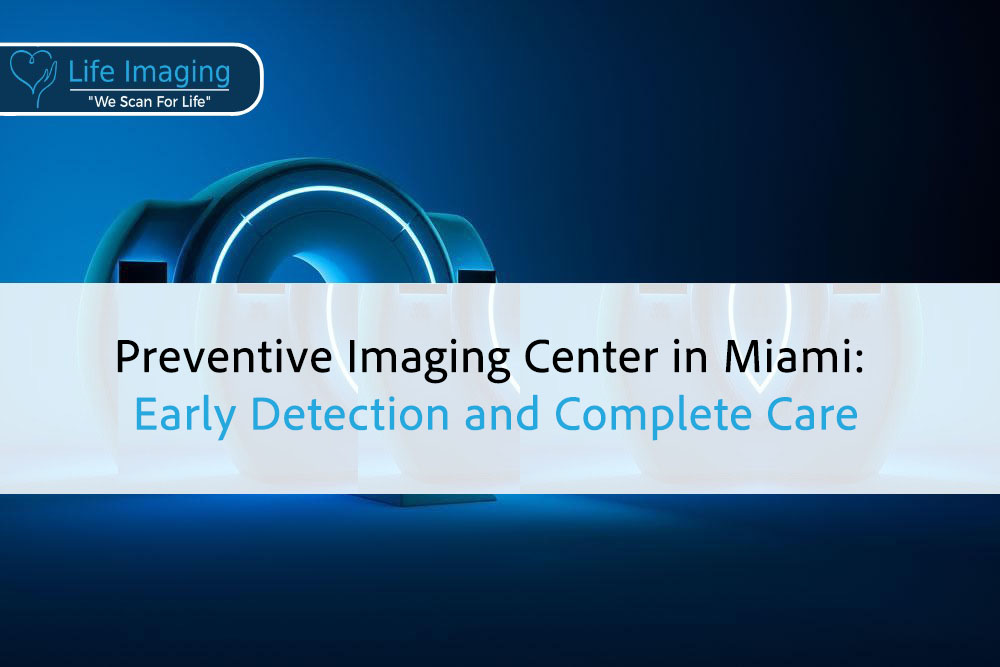
Coronary Artery Scan Near Me in Jupiter: Early Heart Health Detection
Introduction Your heart works hard every second of the day,
NOW OPEN! We’re excited to announce our new location in Jupiter, FL is now open! Learn more.

Maintaining uterus health is crucial for women’s overall well-being and can significantly impact their quality of life. The uterus, a vital reproductive organ, plays a significant role in menstruation, pregnancy, and childbirth. However, uterus-related health issues, including cancer, fibroids, and endometriosis, can arise, affecting many women globally. Early detection of these conditions is essential for effective treatment and better health outcomes.
Imaging techniques have become indispensable tools in the early detection and diagnosis of uterine health issues. From ultrasounds and MRIs to advanced technologies like PET scans and CT scans, these diagnostic tools provide detailed insights into the condition of the uterus. At Life Imaging Fla, we specialize in the early detection of heart disease and cancer through state-of-the-art imaging techniques, ensuring comprehensive care for our patients.
In this article, we will explore the importance of uterus health and the role of imaging in the early detection of uterine conditions. We will discuss various imaging techniques, their applications, and the benefits they offer in diagnosing uterine health issues. By understanding these methods, we can emphasize the importance of regular screenings and early intervention, ultimately leading to improved health outcomes for women. Dive in as we discuss how cutting-edge imaging technologies at Life Imaging Fla can support and enhance uterine health management.
The health of the uterus is vital for menstruation, fertility, and overall well-being. Problems like fibroids, endometriosis, and cancer can significantly affect women’s health. Detecting these issues early is crucial to ensure effective treatment and prevent complications.

Fibroids are non-cancerous growths in the uterus that can cause pain and heavy menstrual bleeding. They can vary in size and number. While many fibroids do not require treatment, some can lead to severe symptoms that necessitate medical intervention.
Endometriosis occurs when tissue similar to the lining inside the uterus grows outside of it. This condition causes pain, especially during menstruation, and can lead to fertility problems. Early detection and treatment can help manage symptoms and improve quality of life.
Uterine cancer, particularly endometrial cancer, affects the lining of the uterus. It is one of the most common cancers affecting women. Symptoms include abnormal bleeding, pelvic pain, and weight loss. Early detection is key to successful treatment and improving survival rates.
Ultrasound is often the first imaging technique used to assess uterus health. It uses high-frequency sound waves to create images of the uterus and other pelvic organs.
– Transabdominal Ultrasound: This involves placing the ultrasound probe on the abdomen to get a broad view of the pelvic area.
– Transvaginal Ultrasound: This involves inserting the probe into the vagina to get more detailed images of the uterus and surrounding organs.
These methods help detect abnormalities like fibroids, cysts, and thickening of the uterine lining.
MRI uses magnetic fields and radio waves to produce detailed images of the uterus and surrounding tissues. It provides high-resolution images that can help diagnose various conditions.
– Soft Tissue Detail: MRI gives clear images of soft tissues, making it easier to detect tumors, fibroids, and endometriosis.
– No Radiation: MRI does not involve radiation, making it a safe option for repeated use.
MRIs can provide a more detailed view when ultrasounds are inconclusive or when more information is needed.
CT scans use X-rays to create detailed cross-sectional images of the body. While not commonly used as the first step for detecting uterine issues, CT scans can be useful in certain situations.
– Detailed Images: CT scans provide detailed images of the uterus and surrounding organs, helping to identify tumors and their spread.
– Staging Cancer: These scans can help determine the stage of uterine cancer and guide treatment planning.
CT scans are particularly useful for assessing the extent of cancer and planning surgical procedures.
PET scans use a radioactive tracer to reveal how tissues and organs are functioning. This technique is valuable in detecting cancer and understanding its spread.
– Radioactive Sugar: The tracer, often a form of sugar, is absorbed more by cancer cells, making them visible on the scan.
– Evaluating Spread: PET scans help determine whether uterine cancer has spread to other parts of the body.
This method is effective in staging cancer and monitoring treatment response.
Hysteroscopy
Hysteroscopy is a procedure that involves inserting a thin, lighted tube through the vagina and cervix into the uterus. It allows doctors to directly view the inside of the uterus.
– Direct Visualization: Hysteroscopy provides a clear view of the uterine lining, helping to identify abnormalities like polyps and fibroids.
– Guiding Biopsies: This technique can also guide biopsies, ensuring tissue samples are taken from suspicious areas.
Hysteroscopy is useful for both diagnosing and treating certain uterine conditions.
Regular screenings and check-ups are essential for maintaining uterus health, especially for women at higher risk of uterine problems. Early detection through imaging techniques can significantly improve treatment outcomes and quality of life.
Understanding and identifying risk factors can help in early detection. These factors include:
– Age: The risk of uterine cancer increases with age, particularly after menopause.
– Family History: A family history of uterine or other related cancers can increase risk.
– Obesity: Excess weight is a known risk factor for several uterine conditions.
Recognizing these factors enables more focused and frequent screenings.
Following recommended screening guidelines ensures timely detection of potential problems. These guidelines may include:
– Pap Smear: Regular Pap smears can help detect abnormal cells in the cervix, which might indicate precancerous conditions.
– Ultrasound: Periodic ultrasounds, especially for women with symptoms like heavy bleeding, can detect fibroids and other abnormalities.
– Endometrial Biopsy: Women at higher risk or with abnormal bleeding may need an endometrial biopsy to check for cancer.
Adhering to these guidelines promotes early intervention and better health outcomes.
Healthy lifestyle choices can also play a significant role in maintaining uterus health and preventing potential problems.
Eating a balanced diet rich in fruits, vegetables, whole grains, and lean proteins can support overall reproductive health.
– Antioxidants: Foods rich in antioxidants, such as berries and nuts, help reduce inflammation and support cell health.
– Reducing Red Meat: Limiting the intake of red meat and processed foods can lower the risk of developing certain uterine conditions.
A healthy diet contributes to overall well-being and can reduce the risk of uterine problems.
Regular physical activity helps maintain a healthy weight and reduce the risk of various health issues, including those affecting the uterus.
– Weight Management: Maintaining a healthy weight through exercise reduces the risk of conditions like polycystic ovary syndrome (PCOS) and uterine cancer.
– Improving Circulation: Exercise improves blood circulation, which is beneficial for reproductive health.
Incorporating regular exercise into daily routines supports uterus health.

Avoiding exposure to harmful substances can protect reproductive health.
– Tobacco and Alcohol: Limiting or avoiding tobacco and alcohol can lower the risk of uterine and other related cancers.
– Environmental Toxins: Avoiding exposure to harmful chemicals and pollutants also promotes better health.
Being mindful of toxin exposure helps maintain a healthy uterus.
Early detection of uterine health issues is crucial for effective treatment and better health outcomes. Utilizing advanced imaging techniques and following regular screening guidelines can significantly improve the chances of detecting problems early.
Early detection allows for timely treatment, preventing the progression of conditions like cancer and endometriosis.
– Less Invasive Treatments: Detecting issues early can result in less invasive treatment options and better recovery outcomes.
– Reduced Complications: Early intervention can minimize complications and improve quality of life.
Prioritizing early detection supports overall reproductive health and well-being.
For conditions like uterine cancer, early detection is directly linked to improved survival rates.
– Stage-Specific Outcomes: The earlier cancer is detected, the more likely it is to be at a treatable stage, significantly enhancing survival rates.
– Effective Monitoring: Regular screenings help monitor existing conditions, ensuring timely adjustments to treatment plans.
Focusing on early detection saves lives and enhances health outcomes.
Advanced Imaging Techniques for Uterine Health
3D ultrasound is an advanced version of traditional ultrasound. It uses high-frequency sound waves to create three-dimensional images of the uterus.
– Detailed Structure: 3D ultrasound helps provide a clear view of the uterine structure, identifying abnormalities such as fibroids, polyps, or congenital defects.
– Better Diagnosis: This method can improve the accuracy of diagnosing various conditions compared to traditional 2D ultrasound.
3D ultrasound is safe and non-invasive, offering a more detailed look at the uterus.
Doppler ultrasound measures blood flow in the uterine arteries and other pelvic structures. This information can help assess various conditions.
– Blood Flow Measurement: Doppler ultrasound helps determine the presence of abnormal blood flow patterns, which can be signs of conditions like fibroids or cancer.
– Pregnancy Monitoring: This technique is valuable in monitoring pregnancies by assessing the blood flow to the placenta and fetus, ensuring healthy development.
Using Doppler ultrasound enhances the understanding of uterine and fetal health.
An endometrial biopsy involves taking a small tissue sample from the lining of the uterus for examination.
– Detecting Cancer: This procedure helps detect endometrial cancer or precancerous changes, especially in women experiencing abnormal uterine bleeding.
– Minimally Invasive: The biopsy is typically performed in a doctor’s office and does not require significant recovery time.
Endometrial biopsy is a critical tool for diagnosing serious uterine conditions early.
A hysteroscopic biopsy combines hysteroscopy and tissue sampling, allowing direct visual inspection and targeted biopsy of suspicious areas inside the uterus.
– Precise Sampling: The direct view enables precise targeting, increasing the likelihood of detecting abnormalities.
– Comprehensive Diagnosis: This method can help diagnose conditions like fibroids, polyps, and cancer more accurately.
Hysteroscopic biopsy provides a comprehensive approach to diagnosing uterine health issues.
Regular pelvic exams are fundamental in maintaining uterine health. These exams allow healthcare providers to detect any abnormalities early.
– Physical Examination: During a pelvic exam, doctors feel the size, shape, and position of the uterus and other reproductive organs.
– Screening for Problems: Regular exams help identify signs of infections, cysts, or other abnormalities early, facilitating timely intervention.
Combining pelvic exams with imaging tests offers a robust strategy for early detection.
Non-Imaging Diagnostic Methods
A Pap smear is a simple procedure where cells from the cervix are collected and examined under a microscope.
– Detecting Changes: This test looks for changes in cervical cells that might indicate precancerous or cancerous conditions.
– Routine Screening: Regular Pap smears are a standard part of women’s health check-ups, helping in early detection of cervical and other related cancers.
Pap smears are a valuable component of regular health screenings.
Human Papillomavirus (HPV) testing involves checking for the presence of the virus that can cause cervical cancer.
– Identifying Risks: HPV testing helps identify women at higher risk for developing cervical cancer, allowing for preventive measures.
– Complementing Pap Smear: This test is often done along with a Pap smear to provide a more comprehensive assessment.
HPV testing aids in early detection and prevention efforts for cervical health.
Artificial Intelligence (AI) is revolutionizing imaging techniques in healthcare by enhancing accuracy and efficiency.
– AI Algorithms: AI algorithms analyze images to detect subtle abnormalities that might be missed by the human eye.
– Automated Analysis: These technologies enable automated analysis, making the process faster and more reliable.
AI improves the precision and effectiveness of uterine health diagnoses.
Telemedicine allows healthcare providers to deliver care remotely using digital technology.
– Virtual Consultations: Patients can consult specialists from the comfort of their homes, ensuring timely follow-ups and management of uterine health issues.
– Access to Experts: Telemedicine makes it easier to access expert opinions and second opinions, especially valuable for complex cases.
Telemedicine enhances accessibility and convenience in managing uterine health.
Early detection of uterine health issues can greatly reduce health risks and complications.
– Preventive Treatment: Early intervention can prevent the progression of conditions, reducing the need for invasive procedures.
– Improved Outcomes: Detecting issues early often results in more effective treatments and better health outcomes.
Prioritizing early detection promotes overall reproductive health.
Managing uterine health issues promptly can significantly improve a woman’s quality of life.
– Symptom Relief: Early diagnosis and treatment can alleviate symptoms like pain and heavy bleeding, improving daily life.
– Fertility Preservation: Early treatment can help preserve fertility, allowing women to plan future pregnancies.
Focusing on early detection enhances well-being and reproductive health.
Educating women about the symptoms of uterine health issues empowers them to seek medical care promptly.
– Recognizing Signs: Knowing the signs of conditions like fibroids, endometriosis, and cancer helps women take action early.
– Seeking Help: Encouraging women to seek medical help at the first sign of trouble can lead to earlier diagnoses and better outcomes.
Awareness and education are key to promoting uterine health.
Understanding available treatment options helps women make informed decisions about their health.
– Informed Choices: Educated patients are better equipped to discuss treatment options with their healthcare providers and choose the best plan.
– Managing Expectations: Knowing what to expect from different treatments can help manage expectations and reduce anxiety.
Patient education supports better health decisions and outcomes.
Continued research in uterine health is crucial for developing better diagnostic methods and treatments.
– New Techniques: Research leads to the discovery of new imaging techniques and biomarkers that improve early detection.
– Clinical Trials: Participation in clinical trials can provide access to cutting-edge treatments and contribute to medical advancements.
Ongoing research enhances the understanding and management of uterine health.
Technological advances are continuously improving how uterine health issues are detected and treated.
– New Diagnostics: Innovations in imaging and diagnostics offer more accurate and less invasive methods for detecting problems.
– Enhanced Treatments: Advances in surgical techniques and medications improve treatment options and outcomes for patients.
Embracing technological advances ensures the best care for uterine health.
By integrating advanced imaging techniques, promoting regular screenings, and prioritizing patient education, healthcare providers can significantly enhance early detection and treatment of uterine health issues. This proactive approach helps ensure better health outcomes and an improved quality of life for women.
The Role of Genetic Testing
Genetic testing can identify inherited risks for uterine health issues, including cancer. This testing examines specific genes known to contribute to these conditions.
– BRCA Mutations: Mutations in BRCA1 and BRCA2 genes can increase the risk of uterine and other cancers.
– Lynch Syndrome: This inherited condition elevates the risk of several cancers, including uterine cancer. Genetic testing can identify if someone carries the associated genetic mutations.
Knowing genetic risks helps doctors and patients make informed decisions about surveillance and preventive measures.
Understanding genetic predispositions allows for personalized prevention strategies.
– Increased Surveillance: Those with a higher genetic risk can benefit from more frequent screenings and earlier intervention.
– Preventive Surgery: In some cases, preventive surgery, such as removing the uterus, may be considered to reduce cancer risk significantly.
Personalized prevention strategies improve early detection and health outcomes.
The Importance of Blood Tests
Blood tests can measure hormone levels, providing valuable insights into uterine health.
– Estrogen and Progesterone: Imbalances in these hormones can lead to conditions like endometrial hyperplasia and cancer.
– Thyroid Hormones: The thyroid gland influences many aspects of health, including menstrual regularity and uterine function. Abnormal thyroid levels can affect the uterus.
Monitoring hormone levels helps diagnose and manage various uterine health issues.
Certain biomarkers in the blood can indicate the presence of uterine conditions.
– CA-125: This marker is often elevated in women with uterine or ovarian cancer, helping in early detection.
– HE4: Another marker that, when elevated, can indicate gynecologic cancers.
Regular blood tests can catch these markers early, leading to faster diagnosis and treatment.
The Role of Lifestyle in Uterus Health
A healthy diet plays a crucial role in maintaining uterus health.
– Anti-inflammatory Foods: Foods like berries, fatty fish, and leafy greens reduce inflammation, which can lower the risk of uterine conditions.
– High Fiber: A high-fiber diet helps regulate hormones, which can reduce risks related to estrogen imbalances.
Making dietary changes can have a positive impact on uterine health.
Regular physical activity supports overall reproductive health.
– Weight Management: Maintaining a healthy weight reduces the risk of conditions like uterine fibroids and cancer.
– Improved Circulation: Exercise improves blood flow to the pelvis, benefiting the uterus and other reproductive organs.
Incorporating physical activity into daily routines enhances uterine health.
Minimizing exposure to harmful substances can protect the uterus.
– Tobacco and Alcohol: Smoking and excessive alcohol consumption increase the risk of various uterine conditions, including cancer.
– Environmental Toxins: Reducing exposure to harmful chemicals at home and work helps maintain overall health.
Avoiding these substances supports better uterine health.
Acupuncture may offer relief for symptoms related to uterine conditions.
– Pain Management: This technique can help manage pain associated with conditions like endometriosis and fibroids.
– Hormonal Balance: Acupuncture may aid in balancing hormones, improving symptoms of menstrual irregularities.
Incorporating acupuncture can complement traditional treatments.

Herbal remedies can support uterine health naturally.
– Vitex (Chasteberry): Known for regulating menstrual cycles and reducing symptoms of PMS and menopause.
– Turmeric: This anti-inflammatory herb can help reduce symptoms of uterine conditions like fibroids.
Using herbal remedies can be an effective part of a well-rounded approach to uterine health.
Mind-body practices such as yoga and meditation support emotional and physical well-being.
– Stress Reduction: Lowering stress can positively impact hormonal balance and reproductive health.
– Physical Benefits: Yoga improves flexibility and circulation, which can support uterine health.
Incorporating these practices helps maintain overall well-being and uterine health.
The Importance of Mental Health
Maintaining good mental health is essential for overall uterine health.
– Stress Management: Chronic stress can negatively impact hormonal balance and menstrual cycles.
– Support Systems: Having a strong support system, including family and friends, can help manage emotional health.
Prioritizing emotional well-being enhances overall health, including uterine health.
Seeking professional support from mental health providers can be beneficial.
– Therapy and Counseling: Therapists can provide strategies to manage stress and emotional challenges related to uterine health issues.
– Support Groups: Joining support groups for women with similar health conditions can offer emotional support and practical advice.
Professional support aids in managing the emotional aspects of uterine health.
The Comprehensive Approach to Uterine Health
A comprehensive approach to uterine health involves integrating various strategies, including medical treatments, lifestyle changes, and alternative therapies.
– Holistic Care: Combining traditional and alternative therapies ensures holistic care, addressing both physical and emotional well-being.
– Personalized Plans: Tailoring care plans to individual needs provides more effective and personalized treatment options.
A comprehensive approach ensures the best possible outcomes for uterine health.
Consistent monitoring is key to maintaining uterine health and catching any issues early.
– Routine Check-ups: Regular visits to healthcare providers allow for continuous monitoring and early detection.
– Self-Awareness: Being aware of changes in one’s body and reporting them promptly can lead to quicker diagnoses and treatments.
Regular monitoring promotes proactive health management.
Staying informed about uterine health is crucial for early detection and effective management.
– Health Workshops: Attending workshops and seminars can provide up-to-date information on maintaining uterine health.
– Reliable Sources: Reading information from reliable sources ensures access to accurate and helpful knowledge.
Ongoing education empowers women to take charge of their uterine health.
By incorporating regular check-ups, personalized care plans, and staying informed, women can proactively manage their uterine health. These practices support early detection and enhance overall well-being, ultimately leading to better health outcomes.
Early detection and proactive management of uterine health issues are essential for maintaining overall well-being and quality of life. By leveraging advanced imaging techniques, genetic testing, regular screenings, and personalized care plans, women can better monitor and manage their uterine health. Incorporating a healthy lifestyle, mental health support, and alternative therapies offers a holistic approach that supports both physical and emotional well-being.
At Life Imaging Fla, we are committed to providing state-of-the-art imaging services that aid in the early detection of various health issues, including those related to uterine health. Our advanced technology and comprehensive diagnostic tools ensure that you receive accurate and timely information about your health.
Take charge of your health today. Schedule an appointment with Life Imaging Fla to explore our range of imaging services and learn more about maintaining optimal uterine health. Your well-being is our top priority, and we are here to support you every step of the way.

Introduction Your heart works hard every second of the day,

Introduction Your heart works around the clock, but changes inside

Introduction Your heart works nonstop, often without a single complaint.

Introduction The best part of getting older is having time

Introduction Good health isn’t just about treating problems, it’s about

Introduction Cancer often begins quietly, long before you feel anything

* Get your free heart scan by confirming a few minimum requirements.
Our team will verify that you qualify before your scan is booked.
Copyright © 2025 Life Imaging – All Rights Reserved